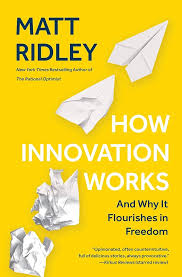How Innovation Works in Freedom: A Comprehensive White Paper
Introduction
Innovation, the engine of progress, is not a solitary act but a collective effort fueled by individual ingenuity and societal freedom. This white paper delves into the intricate relationship between freedom and innovation, exploring how liberty fosters creativity, experimentation, and the development of groundbreaking ideas.
The Indispensable Role of Freedom
Freedom, in its various forms, is the catalyst for innovation. It provides the necessary conditions for individuals to:
- Think Freely: Intellectual freedom allows for the unhindered exploration of ideas, challenging conventional wisdom, and questioning the status quo.
- Experiment Fearlessly: The liberty to fail and learn from mistakes is essential for innovation. A permissive environment encourages risk-taking and experimentation.
- Collaborate Openly: Freedom of association enables individuals to form diverse teams and share knowledge, fostering cross-pollination of ideas.
- Compete Fairly: A competitive market incentivizes innovation, as businesses strive to outdo one another with new products and services.
Case Studies: Innovation Flourishing in Freedom
- The Silicon Valley Phenomenon:
- Key Factors:
- Strong culture of risk-taking and entrepreneurship
- Intellectual property protection
- Access to venture capital
- Immigration policies that attract talent
- Innovations: The internet, personal computers, smartphones, social media, and countless other technological advancements.
- Key Factors:
- The Open-Source Movement:
- Key Factors:
- Collaborative development model
- Free access to source code
- Global community of developers
- Innovations: Linux operating system, Apache web server, and numerous open-source software tools.
- Key Factors:
- The Renaissance Era:
- Key Factors:
- Urbanization and increased trade
- Patronage system supporting artists and scientists
- Intellectual and cultural exchange
- Innovations: Scientific discoveries, artistic masterpieces, and technological advancements.
- Key Factors:
The Dark Side of Excessive Regulation
While regulations can play a role in ensuring safety and fairness, excessive government intervention can stifle innovation. Overly burdensome regulations can:
- Increase Costs: Compliance costs can hinder small businesses and startups.
- Discourage Risk-Taking: Fear of regulatory penalties can discourage experimentation and innovation.
- Create Barriers to Entry: Complex regulations can create barriers for new entrants to the market.
The Future of Innovation: Balancing Freedom and Regulation
To foster innovation, policymakers should strive to create an environment that balances individual liberty with societal needs. This entails:
- Intellectual Property Protection: Strong IP laws incentivize innovation by protecting the rights of inventors and creators.
- Minimal Regulation: A light-touch regulatory approach can encourage entrepreneurship and risk-taking.
- Education and Skill Development: Investing in education and training can equip individuals with the skills needed to innovate.
- Infrastructure and Technology: Robust infrastructure and access to technology are essential for innovation.
Conclusion
Freedom is the lifeblood of innovation. By understanding the intricate relationship between liberty and creativity, we can unlock the full potential of human ingenuity. As we navigate the challenges of the 21st century, it is imperative to prioritize policies that foster innovation and ensure a prosperous future for all.
References:
- Ridley, Matt. How Innovation Works: And Why It Flourishes in Freedom. HarperCollins Publishers, 2020.
- Diamond, Jared. Guns, Germs, and Steel: The Fates of Human Societies. W. W. Norton & Company, 1997.
- Mokyr, Joel. The Lever of Riches: Technological Creativity and Economic Progress. Oxford University Press, 1990.
Additional Resources:
- The Cato Institute
- The Fraser Institute
- The Mercatus Center
By fostering freedom, we empower individuals to dream, create, and shape the future.



